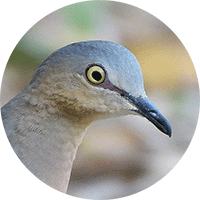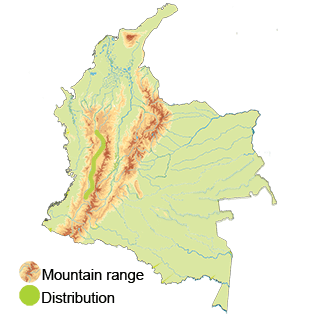Gray-headed Dove
The Gray-headed Dove (Leptotila plumbeiceps). Read in Spanish
Appearance: The Gray-headed Dove is a medium-sized, stout dove with a distinctive gray head, neck, and breast. It has a pale gray belly and undertail coverts and a brownish-gray back and wings. The tail is long and rounded with white tips on the outer feathers. The eyes are dark, and the bill is short and black.
Habitat: This dove species typically inhabits humid forests, often preferring the understory and dense vegetation for cover. They are also found in woodland edges, secondary growth, plantations, and sometimes in parks and gardens with suitable vegetation.
Behavior: Gray-headed Doves are generally shy and secretive birds, often staying hidden in thick vegetation. They are predominantly ground feeders, foraging for seeds, fruits, and insects. Their call is a soft, mournful "cooo" or "cooo-coo-coo" sound.
Breeding: Breeding behavior of the Gray-headed Dove in Colombia is not extensively documented, but they generally build simple nests in trees or shrubs. The female typically lays one or two white eggs, and both parents contribute to incubating the eggs and caring for the young.
Conservation Status:
- The conservation status of the Gray-headed Dove in Colombia is considered of Least Concern according to the International Union for Conservation of Nature (IUCN) Red List.
Distribution
The Gray-headed Dove (Leptotila plumbeiceps),
Central Andes: The Gray-headed Dove is primarily found in the Central Andes region of Colombia, which includes several departments such as Tolima, Huila, Risaralda, Caldas, and Quindio. This region, characterized by its montane forests and cloud forests, provides the ideal habitat for the Gray-headed Dove.
Tolima Department: The Tolima Department, located in the central part of Colombia, is one of the key regions where the Gray-headed Dove is known to occur. Within Tolima, the species can be found in forested areas at varying elevations.
Huila Department: The Huila Department, located to the south of Tolima, is another important area for the Gray-headed Dove's distribution. The bird is known to inhabit montane forests and humid areas within Huila.
Quindio Department: The Quindio Department, located west of Tolima and north of Huila, also provides suitable habitat for the Gray-headed Dove. The species can be observed in specific forested areas within Quindio, particularly within the Central Andes mountain range.
Taxonomy
The Gray-headed Dove (Leptotila plumbeiceps),
- Kingdom: Animalia
- Phylum: Chordata
- Class: Aves (Birds)
- Order: Columbiformes
- Family: Columbidae
- Genus: Leptotila
- Species: Leptotila plumbeiceps
Vocalization
The Gray-headed Dove (Leptotila plumbeiceps)
- Call: The vocalizations of the Gray-headed Dove are characterized by a series of low, mournful, and rhythmic cooing sounds. The typical call of the Gray-headed Dove is often described as a repetitive "coo-cooooo" or "cooooo-cooo," with a melodic and soothing quality.
- Advertising Call: During the breeding season, male Gray-headed Doves may modify their usual call to produce a more elaborate advertising call to attract potential mates. The advertising call is often louder and more persistent, serving as a signal of the male's presence and reproductive readiness.
- Duetting: Gray-headed Doves engage in duetting, where both male and female birds participate in coordinated vocalizations. Duetting is a form of communication between mates, strengthening their bond and reinforcing their pair's territory.
- Alarm Calls: When threatened or alarmed, Gray-headed Doves emit rapid and repetitive alarm calls, signaling danger to others in their vicinity. Alarm calls help to alert nearby doves to potential threats and coordinate a response to perceived danger.
- Interaction Calls: Gray-headed Doves use a variety of softer and more subtle vocalizations during social interactions, such as feeding together or roosting in close proximity. These interaction calls facilitate communication within the group and contribute to the overall social dynamics of the species.




